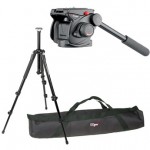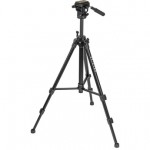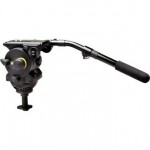Tripods for DSLR video making
Monday, January 31, 2011

Being very much aware of changing trends in the video world, Manfrotto revised their proven 503 fluid head taking into account the increasing performance demands of High Definition Mini-DV camcorders. The result is the 503HDV Pro. Has Continuously-variable fluid drag, multi-spring 3 step counterbalance, and sliding balance plate with 58mm of travel.
 I’ve used the Pearstone VT-2100 Video Tripod for over 2 years now. And while its not the smoothest head out there its price, and size work very well for HDSLR work. Its a portable, lightweight video tripod that can support cameras weighing up to 15 lbs. Its two-way pan head features separate pan and tilt locks for stable, locked-down shots, or you can pan a full 360° and tilt up and down for smooth tracking of action.
I’ve used the Pearstone VT-2100 Video Tripod for over 2 years now. And while its not the smoothest head out there its price, and size work very well for HDSLR work. Its a portable, lightweight video tripod that can support cameras weighing up to 15 lbs. Its two-way pan head features separate pan and tilt locks for stable, locked-down shots, or you can pan a full 360° and tilt up and down for smooth tracking of action.
 The Vision 100 ain’t cheap, but I have several hundred hours on this head and its the smoothest most reliable tripod head I have ever worked with. Designed and engineered to new advanced levels, it is the perfect head for today’s latest digital camera configurations. Incorporating a drag mechanism employing non-contacting thin film technology, which ensures consistent drag and constant performance over a temperature range from -40°F to +140°F.
The Vision 100 ain’t cheap, but I have several hundred hours on this head and its the smoothest most reliable tripod head I have ever worked with. Designed and engineered to new advanced levels, it is the perfect head for today’s latest digital camera configurations. Incorporating a drag mechanism employing non-contacting thin film technology, which ensures consistent drag and constant performance over a temperature range from -40°F to +140°F.









[get this widget]
Lenses recommended for dslr videography
Tuesday, January 18, 2011

I’ve written a bit about DSLR Videography here, and with the rumors of the new Noktor lens (50mm F0.95) for Micro Four Thirds coming, it may be of interest to you which lenses to get for shooting video with DSLRs. Here’s a couple to consider.
Canon
24-105mm F4 L IS- By far this is probably one of Canon’s most versatile lenses. If you’re using a 7D, 1D Mk IVor 5D Mk II this lens will be able to provide a wide range of shooting abilities. The cropped field of view on the 7D will make this a must have lens. It allows for great establishing shots or even panning shots.
50mm F1.4/F1.8/Zeiss 50mm F1.4- The 1.8 is the cheapest and gives great results when stopped down. The Canon 1.4 is one of Canon’s best lenses and provides great results when shooting wide open. The Zeiss is fully manual focus and can provide some amazing depth of field and great image quality in low light.
70-200mm F2.8 L IS- As one of Canon’s most popular lenses, it should be had when doing telephoto shooting or want a flatter look to your video. It could be nice for shot-reverse-shot video.
35mm F2/1.4 L- These two wide angle lenses are very nice and provide some of the best views at this focal length for video. Once again, great for establishing shots.
Pentax
Pentax Normal SMCP-FA 50mm f/1.4- If you have the K-7 or the K-x, this is the lens to get as it will offer you so much versatility when shooting coupled with great imaging capabilities. Great for general use.
Pentax smc Pentax FA 31mm f/1.8 Limited- Because of the 1.5x cropped sensor on Pentax DSLRs, this is an essential lens. Also great for general use and a normal field of view.
Pentax Zoom Normal-Telephoto SMCP-DA* 50-135mm f/2.8 ED (IF) SDM- For all your telephoto work and for a flatter look. Nice for shooting wildlife.
Nikon
85mm F1.4- As one of the yummiest lenses I’ve ever tested, this will allow you to have very shallow depth of field to focus on your subjects while filming. Nice for interviews and profile shots.
24-70mm F2.8 ED- Though not as versatile for videography as Canon’s 24-105, it still gets the job done when using something like a D3s. Great for interviews.
70-200mm F2.8 ED VR II- Nikon’s version of this lens render’s colors beautifully and is very, very sharp. It will help when shooting at 24p. Though I recommend using it with a tripod.
12-24mm F4 G ED- Best used with Nikon’s cropped sensor cameras, this lens will give you a great field of view when shooting video. Use it with the full framers when you’re shooting establishing shots.
Micro Four Thirds
Canon FD 24mm F1.4 L- If you can get your hands on one, this lens will be excellent as you’ll be using nice old-time Canon glass that provides for great color rendition and quality.
PanaLeica 25mm F1.4- As probably my favorite Four Thirds lens, it makes having the adapter all the more useful. What’s even better is because of the 2x crop factor you’re getting a 50mm field of view which is great for general use.
Sigma 18-50mm F2.8- This will probably be your most versatile lens as you’ll be able to use this for wide shots, interviews, shot-reverse-shots, etc.
Panasonic 20mm F1.7- As the favorite lens of current Micro Four Thirds users, it’s obviously great for video. It will allow for great sharpness while still keeping your package compact so you can attach microphones and other accessories if needed.









[get this widget]
For Story telling with DSLR, how important is Depth of Field
Wednesday, January 5, 2011

With HDSLRs, and now large sensor video cameras, those of us who shoot video have blessed with the ability to shoot insanely shallow depth of field (DOF). For the last 12 months we have been bombarded with videos shot at F1.8 and faster, and while shallow DOF can look gorgeous I believe a lot of people have not fully harnessed the power, and use, of depth using their lenses aperture.
So rather than complain about it, here are some points I have been learning about DOF in my journey as an ever-aspiring filmmaker.
1. Don’t be afraid of Deep DOF

“To make your video look like film use shallow depth of field.” This is a line I hear a lot, especially from DSLR shooters and it could not be farther from the truth. Yes, films use shallow DOF but that does not make them films. Depth of field is a tool with which to sculpt your shots. So just because we can now shoot at F1.2 does not mean we should. I know most of us are recovering from Large Sensor Deficiency Syndrome but with a little education and therapy, we can move on.
2. Understanding Selective Focus
Selective focus is simply using DOF to isolate a subject. The shot below is from Defiance and is an excellent example of selective focus. While there are subjects walking behind and in front of Daniel Craig’s character, our focus is on him:

Using this method you can direct the focus of your audience toward whatever element you desire to showcase. Thus subconsciously telling them “this is important.”
Its also important to be thinking about how shallow to shoot. Study this shot from The Social Network:

We are instantly focused on the character in the center of the shot. As we examine it, we notice to the camera right another key character.
Now look what happens when we look at a shot that is in all ways identical to the last, except for a difference in DOF:

In this shot the DOF is far shallower than the first. Two problems become apparent. The first is how odd and unnatural it looks. The people on the left are now unrecognizable blobs, and the character center screen sticks out too much. This is a BIG problem. The last thing you want to do is distract your audience and remove them from the story. The second issue with this shot is that we can no longer easily discern who the other character is. Are these the two best friends? Or is the character on the right a complete stranger? We now see how critical the use of DOF is for selective focus.
3. Don’t Create Muddy Shots
Something I see a lot on Vimeo and YouTube is “muddy” shots. These are shots where someone shoots wide open at F2.0 or faster and part of the subject is out of focus, creating a “muddy” look. Here is a shot from Abortion, a short I shot last year where I made this mistake:

Notice the talent’s right eye (our left) is just slightly out of focus. click the image to enlarge. While not terribly noticeable on a computer screen, when displayed on the big screen it becomes far too distracting. After making that mistake I created two rules for myself:
Rule One: When photographing peoples faces I make sure their eyes and face are in focus. Its ok if the hair goes out a bit.
Rule Two: If I do put one eye out of focus it has to be at least a 20% difference from the one in focus. This clearly separates the two. When the eye is just out of focus it becomes distracting.
There are a few exceptions but for the most part I find these rules to help keep my shots from becoming distracting.
People aren’t the only thing to keep from shooting “muddy.” Here are two simple shots that show the difference between a muddy shot and a clear one:
Video
The first shot of the showerhead is the clear one. While the handle is out of focus, it is consistently out all the way down. And the sprayer head is completely in focus. But notice in the seconded shot, half the showerhead is in focus and the other half is out. You can tell it looks sloppy when compared with the first shot. See the difference? The same goes for the book text. Notice the first shot the text is readable and you can tell its a page from a book. While the second shot does have the text in focus, you can barely tell what the rest of the image is. Its all cloudy. If we don’t show that it’s a page from a book the audience may spend time trying to figure out what it is and not read it. Which brings us to our next point.
4. Don’t Confuse Your Audience
Something else to consider when setting your DOF is scene clarity. A great example of good shot clarity can be seen in this shot from Inception:

This is a shot from an obviously complicated scene. In situations like this shooting with deep DOF keeps the layout of environment clear to the audience. Again we don’t won’t to remove the audience from the story by disorienting them, which you can see with this scene would not be hard to do.
Using DOF to Create Intimacy
When you really think about it, DOF is just another framing edge. Just like left, right, top, and bottom of the frame can be used to isolate the scene; DOF can be used to control how deep a scene is. This gives the cinematographer the option to limit space. Take for example a parking lot. While in reality it may be a large space, using shallow depth of field one can create a very small, intimate scene with a character.
Check out this shot from Dear Frankie:

In this scene our two characters are dancing on a large set. Using shallow DOF Cinematographer Shona Auerbach has created a very intimate scene. By putting other people and elements out of focus, he has created a moment that, as viewers, we can really focus and connect with the characters.
Conclusion.

So you can see how powerful DOF can be when used properly. Next time you lens your camera and choose your aperture, take some time to think about depth. Ask yourself the following questions:
What am I shooting?
Where am I directing the eyes of my audience?
Is this depth confusing?
How intimate is this scene?
Why am I using this depth?
So get off the computer, grab your camera and some friends, and tell a story!









[get this widget]




